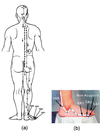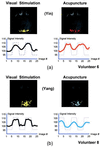New findings of the correlation between acupoints and corresponding brain cortices using functional MRI
- PMID: 9482945
- PMCID: PMC19456
- DOI: 10.1073/pnas.95.5.2670
New findings of the correlation between acupoints and corresponding brain cortices using functional MRI
Retraction in
-
Retraction. New findings of the correlation between acupoints and corresponding brain cortices using functional MRI.Proc Natl Acad Sci U S A. 2006 Jul 5;103(27):10527. doi: 10.1073/pnas.0602520103. Epub 2006 Jun 21. Proc Natl Acad Sci U S A. 2006. PMID: 16790551 Free PMC article. No abstract available.
Abstract
A preliminary study of the correlation between acupuncture points (acupoints) for the treatment of eye disorders suggested by ancient Oriental literature and the corresponding brain localization for vision described by Western medicine was performed by using functional MRI (fMRI). The vision-related acupoint (VA1) is located in the lateral aspect of the foot, and when acupuncture stimulation is performed there, activation of occipital lobes is seen by fMRI. Stimulation of the eye by directly using light results in similar activation in the occipital lobes by fMRI. The experiment was conducted by using conventional checkerboard 8-Hz light-flash stimulation of the eye and observation of the time-course data. This was followed by stimulation of the VA1 by using the same time-course paradigm as visual light stimulation. Results obtained with 12 volunteers yielded very clean data and very close correlations between visual and acupuncture stimulation. We have also stimulated nonacupoints 2 to 5 cm away from the vision-related acupoints on the foot as a control, and activation in the occipital lobes was not observed. The results obtained demonstrate the correlation between activation of specific areas of brain cortices and corresponding acupoint stimulation predicted by ancient acupuncture literature.
Figures






Similar articles
-
Visual cortical activations on fMRI upon stimulation of the vision-implicated acupoints.Neuroreport. 2003 Apr 15;14(5):669-73. doi: 10.1097/00001756-200304150-00002. Neuroreport. 2003. PMID: 12692460 Clinical Trial.
-
Functional magnetic resonance imaging activation of the brain in children: real acupoint versus sham acupoint.J Child Neurol. 2010 Jul;25(7):849-55. doi: 10.1177/0883073809351314. J Child Neurol. 2010. PMID: 20595697 Clinical Trial.
-
Functional neuroanatomical investigation of vision-related acupuncture point specificity--a multisession fMRI study.Hum Brain Mapp. 2009 Jan;30(1):38-46. doi: 10.1002/hbm.20481. Hum Brain Mapp. 2009. PMID: 17990299 Free PMC article.
-
[Application of functional magnetic resonance imaging in acupoint functional significance of encephalic region].Zhongguo Zhen Jiu. 2014 May;34(5):517-20. Zhongguo Zhen Jiu. 2014. PMID: 25022136 Review. Chinese.
-
What is the Acupoint? A preliminary review of Acupoints.Pain Med. 2015 Oct;16(10):1905-15. doi: 10.1111/pme.12761. Epub 2015 May 13. Pain Med. 2015. PMID: 25975413 Review.
Cited by
-
Effects of Electroacupuncture at BL60 on Formalin-Induced Pain in Rats.Evid Based Complement Alternat Med. 2012;2012:324039. doi: 10.1155/2012/324039. Epub 2012 Apr 5. Evid Based Complement Alternat Med. 2012. PMID: 22550540 Free PMC article.
-
An fMRI study comparing brain activation between word generation and electrical stimulation of language-implicated acupoints.Hum Brain Mapp. 2003 Mar;18(3):233-8. doi: 10.1002/hbm.10098. Hum Brain Mapp. 2003. PMID: 12599282 Free PMC article.
-
Is sham laser a valid control for acupuncture trials?Evid Based Complement Alternat Med. 2011;2011:485945. doi: 10.1093/ecam/neq009. Epub 2011 Mar 10. Evid Based Complement Alternat Med. 2011. PMID: 21772922 Free PMC article.
-
Standardizing therapeutic parameters of acupuncture for pain suppression in rats: preliminary study.BMC Complement Altern Med. 2014 Jan 15;14:25. doi: 10.1186/1472-6882-14-25. BMC Complement Altern Med. 2014. PMID: 24422783 Free PMC article.
-
A PET-CT study on the specificity of acupoints through acupuncture treatment in migraine patients.BMC Complement Altern Med. 2012 Aug 15;12:123. doi: 10.1186/1472-6882-12-123. BMC Complement Altern Med. 2012. PMID: 22894176 Free PMC article. Clinical Trial.
References
-
- Kim D H. Acupuncture and Moxibustion. Inc., Seoul, Korea: The Research Institute of Oriental Medicine; 1987.
-
- Stux G, Pomeranz B. Acupuncture. Berlin: Springer; 1987.
-
- Kaptchuk T J. The Web That Has No Weaver. New York: Congdon & Weed; 1983.
-
- Cho Z H, Chan J K, Ericksson L. IEEE Trans Nucl Sci. 1976;23:613–622.
-
- Phelps M E, Mazziotta J C. Science. 1985;228:799–809. - PubMed
Publication types
MeSH terms
LinkOut - more resources
Full Text Sources
Other Literature Sources

